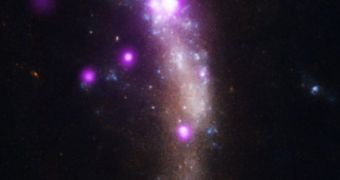When stars explode, a cocoon of gas usually develops in their immediate surroundings. Now, a study conducted using the NASA Chandra X-Ray Observatory provides the first direct evidences of a supernova shock wave breaking through this gaseous envelope.
The investigations team analyzed X-ray signals that Chandra detected starting November 3, 2010. At the time, a galaxy located around 160 million light-years away, called UGC 5189A, produced a luminous supernova event.
Supernovae occur when massive stars at least several times heavier than the Sun reach the end of their burning cycle, and can no longer sustain nuclear fusion. They shed the outer layers of their atmospheres in massive explosions, whose brightness temporarily outshines that of their entire host galaxy.
For many years, astronomers have been proposing that these explosions produced shock waves, which eventually pierced through the thick gaseous envelope surrounding each massive star. However, no direct evidence for this phenomenon was discovered until the new Chandra study.
Scientists now hope that the data will help them figure out several mysteries related to the nature of supernovae, including why some stars blow up in more massive explosions than other stellar objects of similar size, mass and chemical composition.
In the image to the left, purple colors denote X-ray data collected by Chandra, atop a red, green and blue image collected by the NASA Hubble Space Telescope, in optical wavelengths. The supernova proper, SN 2010jl, is located near the top of the galaxy, in its brightest spot.
Details of the new investigation appear in the May 1 issue of the esteemed Astrophysical Journal Letters. The work was compiled by an international team of astronomers.
The team included scientists from Royal Military College of Canada, University of Virginia, Institute of Astronomy of Russian Academy of Sciences, Stockholm University and the Harvard-Smithsonian Center for Astrophysics (CfA).
“In the first Chandra observation of SN 2010jl, the X-rays from the explosion's blast wave were strongly absorbed by a cocoon of dense gas around the supernova. This cocoon was formed by gas blown away from the massive star before it exploded,” a NASA press release accompanying the study says.
“In the second observation taken almost a year later, there is much less absorption of X-ray emission, indicating that the blast wave from the explosion has broken out of the surrounding cocoon,” the statement adds.
“The Chandra data show that the gas emitting the X-rays has a very high temperature – greater than 100 million degrees Kelvin – strong evidence that it has been heated by the supernova blast wave,” the document concludes.

 14 DAY TRIAL //
14 DAY TRIAL //